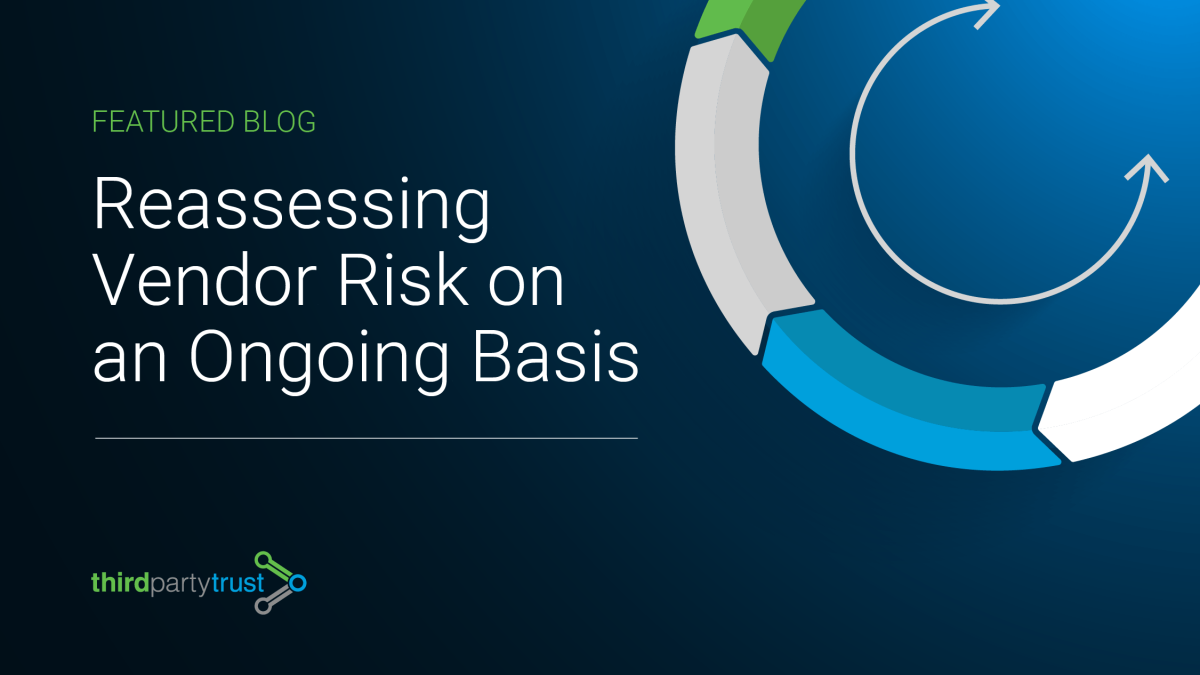Why You Need to Reassess Vendor Risk on an Ongoing Basis
While due diligence is a best practice across industries, it’s equally important –and sometimes underestimated– to reassess vendor risk periodically. Third party risk management (TPRM) does not end at determining the inherent risk of a third party vendor to your organization or getting them to sign a contract. Here’s why you need to perform reassessments, even on vendors that you have been using for a while.
So you’ve done your initial risk rating of a new vendor and decided that you’re comfortable doing business with them. If you have enough resources and an established third party risk management program, you probably plan to conduct a periodic review one year from now.
There are several reasons why this is not enough. A number of things can happen after you sign that contract that impact the vendor’s risk profile, but you wouldn’t be aware of them until next year under this approach. For example:
- A global pandemic forcing thousands of companies to go remote, increasing the risk surface and affecting supply chain operations
- A data breach impacting your vendor and potentially your organization
- Geopolitical risk, natural disasters, or severe power outages
- Mergers or Acquisitions changing your vendor’s strategic direction
- New offices in countries with different regulations around privacy and security
- Lawsuits against your vendor
- A change in the scope of the service provided, by which they may need access to new data, or may even not need certain data anymore
The point-in-time approach of assessing third parties at the beginning of the relationship fails to address new risks that might come along the way as things change. Especially after the covid19 pandemic and the rise in the remote workforce, new and evolving security threats can affect your vendor network. This makes reassessments more critical than ever.
In order to stay on top of significant events, you need to be monitoring risk on an ongoing basis.
Continuous monitoring and the need to reassess vendor risk
To reassess vendor risk essentially means placing them on a new periodic review schedule that dictates new security requirements and standards. Risk levels are not static and can be affected by multiple factors, so it’s part of a comprehensive TPRM strategy to monitor them on an ongoing basis.
What is continuous monitoring? Continuous monitoring is the process of assessing the security controls in place and the changes in the relationship with a third party vendor on an ongoing basis.
After the onboarding process is complete, continuous monitoring practices will help you ensure your third party vendor maintains the desired security posture, and doesn’t expose your organization to unnecessary risk.
This is much more effective than doing an annual assessment, which over time yields less insight and is static in nature, while expensive to perform. How can you guarantee, from a security perspective, that you are OK for the remaining 364 days of the year?
3 tips for your third party risk reassessment process
#1 Define your thresholds
As part of your vendor risk management (VRM) program, Security, Compliance, Legal and Procurement teams should agree on the boundaries of how much risk the organization is prepared to accept. Once you define these thresholds of acceptable risk, communicate them internally and to your vendor ecosystem.
Read more: How to get Legal, Procurement and Business Owners Onboard with Security
It’s important to note the difference between risk appetite and risk tolerance: risk appetite focuses on the level of risk that the organization deems acceptable, whereas risk tolerance focuses on the acceptable level of variation around risk objectives. Defining these boundaries helps setting expectations at the beginning of every new third party relationship and directs TPRM efforts in the right direction.
#2 Rely on security ratings
Security ratings are a big part of continuous monitoring, providing standard KPIs to can track and measure any shifts in a vendor’s security posture. Security ratings are a data-driven, objective, and dynamic measure of security performance that complement a holistic view of third party risk management (TPRM).
Unlike point-in-time snapshots, security ratings are constantly updated, so you can easily track how your vendors’ security posture is changing over time. Fun fact: These ratings are integrated into our ThirdPartyTrust risk management platform to provide a deeper understanding of a vendor’s security posture and achieve true visibility into their inherent risk.
#3 Set up triggers and notifications
Manually setting calendar reminders to send out a spreadsheet with a set of questions is painful. Luckily, there are solutions and best practices available for you to simplify, automate and scale the assessment and reassessment process.
With real-time notifications around third-party activity, you can be up to date on how they’re improving their security posture – whether it be a change to an answer in a questionnaire, an updated security policy or document, or a task completed. You can also receive breach reports, security scorecards and notifications regarding security documentation that’s about to expire.
Given the right toolset, you can also customize and prioritize the types of notifications that you get. You might want to be on top of every change on a critical third party vendor, but for one that’s less critical, it might be enough with alerts on specific risk vectors.
Want more tips and insight into how to monitor your vendors’ cybersecurity postures and identify evolving risks in your supply chain? Download our free strategy guide: 5 Keys to Building a Scalable TPRM Program




